Sold Ceramics
Sold Shipwreck Porcelains
The Nanking Cargo 1752
Tea, Coffee and Chocolate wares
Page 1
The Nanking Cargo
1752
On Monday January 3, 1752, the Dutch East India Company, (Vereenigde Oost-Indische Compagnie, VOC) vessel Geldermalsen, struck a reef on her return journey to the Netherlands and sank in the South China Sea. Of the crew 32 survived and 80 went down with the ship and her cargo of tea, raw silk, textiles, dried wares, groceries, lacquer and porcelain.
The cargo of Chinese porcelain was originally potted in Jingdezhen, Jiangzi province then shipped to Nanking for delivery to the Dutch East India Company, (Vereenigde Oost-Indische Compagnie, VOC) vessel Geldermalsen for final transportation to the Netherlands. The Geldermalsen struck a reef on her return journey to the Netherlands and sank in the South China Sea on January 3, 1752. The cargo was recovered by Captain Michael Hatcher and his team in 1985 and sold by Christie's Amsterdam on 28 April - 2 May 1985 as 'The Nanking Cargo. Chinese Export Porcelain and Gold' two hundred and thirty-five years later. (Jörg 1986/1. pp.39-59).
An interesting detail is that Captain Michael Hatcher found the wreck of the Geldermalsen on the same reef as he earlier, in 1983, found the wreck of a Chinese junk. both wrecks were about a mile apart. This Chinese Junk wreck came to be known as "The Hatcher Junk" she had a cargo of Kraak and Transitional porcelain objects that were dated c.1643. (Sheaf & Kilburn 1988, p.27)
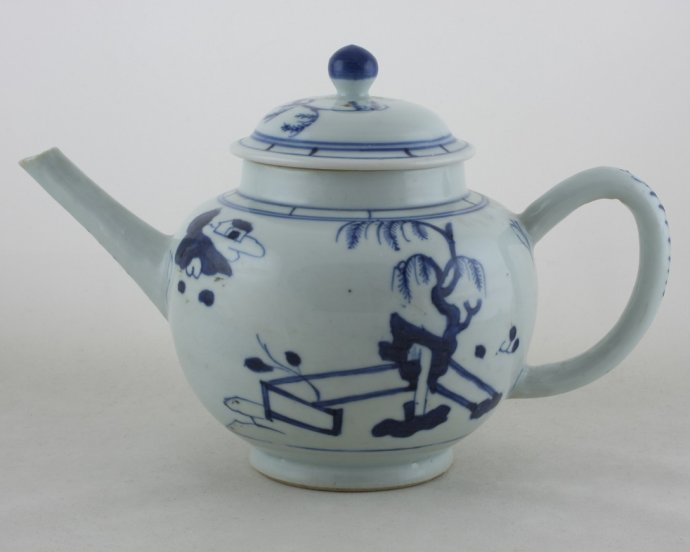
Sold Ceramics - Sold Shipwreck Porcelains - The Nanking Cargo, 1752 - Tea, Coffee and Chocolate wares - Page 1
Object 2012472
Teapot and cover
China
c.1751
Provenance: The Nanking Cargo sale, Christie's Amsterdam, 28 April - 2 May 1986
Height including the cover 145 mm (5.71 inch), diameter handle to spout 217 mm (8.54 inch), diameter of mouthrim 65 mm (2.56 inch), diameter of footring 62 mm (2.44 inch), weight with cover 518 grams (18.27 ounce (oz.)), weight cover 82 grams (2.89 ounce (oz.))
Teapot of globular shape on footring, straight spout with a curved C-shaped handle. Domed cover and pointed knob. Chinese Imari decorated in underglaze blue, and overglaze iron-red with willow issuing from rockwork on a terrace in the foreground and a simple retreat on a distant river bank below a narrow border of trellis pattern. The cover is decorated en suite. On the base the original Christie's The Nanking Cargo lot label and inside the cover the original Christie's The Nanking Cargo lot label with the number 21?? / 4 proving it has been one of 4 similar teapots and covers sold in lots 2173-2176 & 2189-2195. (Amsterdam 1986. p.91)
On Monday January 3, 1752, the Dutch East India Company, (Vereenigde Oost-Indische Compagnie, VOC) ship Geldermalsen, struck a reef on her return journey to the Netherlands and sank in the South China Sea. Of the crew 32 survived and 80 went down with the ship and her cargo of tea, raw silk, textiles, dried wares, groceries, lacquer and porcelain.
The cargo of Chinese porcelain was originally potted in Jingdezhen, Jiangzi province then shipped to Nanking for delivery to the VOC vessel Geldermalsen for final transportation to the Netherlands. The Geldermalsen struck a reef on her return journey to the Netherlands and sank in the South China Sea on January 3, 1752. The cargo was recovered by Captain Michael Hatcher and his team in 1985 and sold by Christie's Amsterdam on 28 April - 2 May 1985 as 'The Nanking Cargo. Chinese Export Porcelain and Gold' two hundred and thirty-five years later. (Jörg 1986/1. pp.39-59).
An interesting detail is that Captain Michael Hatcher found the wreck of the Geldermalsen on the same reef as he earlier, in 1983, found the wreck of a Chinese junk. both wrecks were about a mile apart. This Chinese Junk wreck came to be known as "The Hatcher Junk" she had a cargo of Kraak and Transitional porcelain objects that were dated c.1643. (Sheaf & Kilburn 1988, p.27)
In comparison with the enormous number of tea cups there are remarkably few tea pots on board the Geldermalsen: according to the shipping invoice only 578. Hatcher has been able to recover 522. Was there little demand for tea pots at the time? Even more remarkable is the fact that sugar bowls and tea caddies are completely missing, as well as tea services. Probably the supply of previous years had caused a temporary saturation of the market.
The directors of the Dutch East India Company, (Vereenigde Oost-Indische Compagnie, VOC), the Heeren Zeventien had very strict requirements as regards tea pots: they should have a wide opening and a straight spout. The tea pots found in the wreck correspond to this description. There are two types. One has an ordinary handle, an upright rim and an arched lid with a knob. The decoration - plateau with fence, trees and flowering plants - is once again executed in three ways: in blue-and-white, in Imari and in enamel colours. The second - rarer - type has a pointed handle and a flat lid with a pear-shaped knob. We see here the same motif in blue-and-white and enamel colours. An Imari variety undoubtedly existed as well, but has not been recovered. Once more we are struck by the uniformity of the decoration: only one motif has been bought in. (Jörg 1986/1, p.71)
In total only 77 globular teapots of the first type decorated in blue and enamels (read Imari) were sold divided over the lots: 2171-2197. (Amsterdam 1986)
Tea pots are almost invariably associated with tea sets. The shipping documents mention no other elements of a tea set in the cargo (apart, of course, from the tea bowls, chocolate and coffee cups); but this was a five-year period, 1745-1750, during which the VOC inexplicably bought no fully composed tea sets. We can now extend the period to 1751. A tea set would normally also require a slop bowl, milk jug, one (or two) tea caddies, sugar bowl (for cut or ground cane sugar) and a spoon tray, The Geldermalsen carried none of these as Company wares, although a few of the accessories that one would expect were recovered in an extremely eroded condition: egg-shaped tea caddies, pear-shaped cream jugs and several spoon trays (both in hard paste and the less commonly found soft paste, a beige-coloured, lower-fired variant of normal Chinese porcelain), all presumably isolated 'private cargo'. (Sheaf & Kilburn 1988, p.142)
For an identically shaped, sized and decorated teapot, please see:
Condition: Two firing flaws to the cover and a glaze rough spot to the tip of the spout.
References:
Price: Sold.
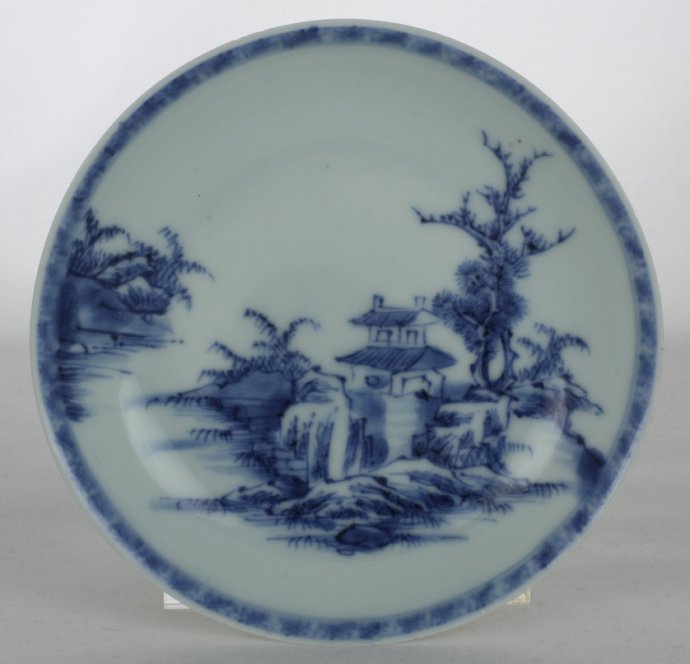
Sold Ceramics - Sold Shipwreck Porcelains - The Nanking Cargo, 1752 - Tea, Coffee and Chocolate wares - Page 1
Object 2010122E
Saucer
China
c.1751
Provenance: The Nanking Cargo sale, Christie's Amsterdam, 28 April - 2 May 1986
Height 18 mm (0.71 inch), diameter of rim 116 mm (4.57 inch), diameter of footring 72 mm (2.84 inch)
Saucer on footring, slightly everted rim. Decorated in underglaze blue at the right with a double-roofed pagoda on a rocky riverbank dividing straggling leafless trees and shrubs, an island appearing in the background at the left. On the rim a trellis pattern border. The reverse is undecorated. On the base the original circular paper Christie's The Nanking Cargo sale lot 5076 label proving it has been 200 similar saucers sold in lot 5076. (Amsterdam 1986, p.224)
The design on this saucer is known as the 'Pagoda Riverscape' pattern, large size. In total 9.328 teacups and saucers and 794 saucers without teacups with the 'Pagoda Riverscape' pattern, large size, were sold divided over the lots: 5033-5066 and 5067-5077. (Amsterdam 1986)
Condition: Perfect.
References:
Sheaf & Kilburn 1988, Pl.137 & Pl.141
Price: Sold.
More pictures of object 2010122C, another identically, shaped, sized and decorated, sold saucer >>
More pictures of object 2010122D, another identically, shaped, sized and decorated, sold saucer >>
More pictures of object 2010122F, another identically, shaped, sized and decorated, sold saucer >>
More pictures of object 2010122G, another identically, shaped, sized and decorated, sold saucer >>
More pictures of object 2010122H, another identically, shaped, sized and decorated, sold saucer >>
More pictures of object 2010122I, another identically, shaped, sized and decorated, sold saucer >>
More pictures of object 2010122J, another identically, shaped, sized and decorated, sold saucer >>
More pictures of object 2010147-1A, another identically, shaped, sized and decorated, sold saucer >>
More pictures of object 2010147-2B, another identically, shaped, sized and decorated, sold saucer >>
More pictures of object 2010147-3C, another identically, shaped, sized and decorated, sold saucer >>
More pictures of object 2010423, another identically, shaped, sized and decorated, sold saucer >>

Sold Ceramics - Sold Shipwreck Porcelains - The Nanking Cargo, 1752 - Tea, Coffee and Chocolate wares - Page 1
Objects 2010524 and 2010525
A pair of teacups and saucers
China
c.1751
Provenance: The Nanking Cargo sale, Christie's Amsterdam, 28 April - 2 May 1986
Height of teacups 35 mm (1.38 inch), diameter of rim 61 mm (2.40 inch), diameter of footring 28 mm (1.10 inch)
Height of saucer 18 mm (0.71 inch), diameter of rim 102 mm (4.02 inch), diameter of footring 62 mm (2.44 inch)
A pair of teacups and saucers on footrings, straight rims. Decorated in underglaze blue at the right with a double-roofed pagoda on a rocky riverbank dividing straggling leafless trees and shrubs, an island appearing in the background at the left. On the rim a trellis pattern border. The reverse is undecorated. The teacup is decorated en suite. On the bases of both teacups and saucers the original circular paper Christie's The Nanking Cargo sale lot 5104 labels proving they have been two of 500 similar teacups and saucers sold in lot 5104. (Amsterdam 1986, p.224)
The two sets are sold in a luxury wooden cassette together with a Certificate of Authenticity (in Dutch) signed by Dr. C.J.A. Jörg.
The design on these teacups & saucers is known as the 'Pagoda Riverscape' pattern, small size. In total 7,698 teacups and saucers and 1,838 teacups without saucers with the 'Pagoda Riverscape' pattern, small size, were sold divided over the lots: 5033-5066 and 5067-5077. (Amsterdam 1986)
Condition:
2010524
Teacup: A chip to the rim.
Saucer: Perfect.
2010525
Teacup: Perfect.
Saucer: Perfect.
References:
Price: Sold.
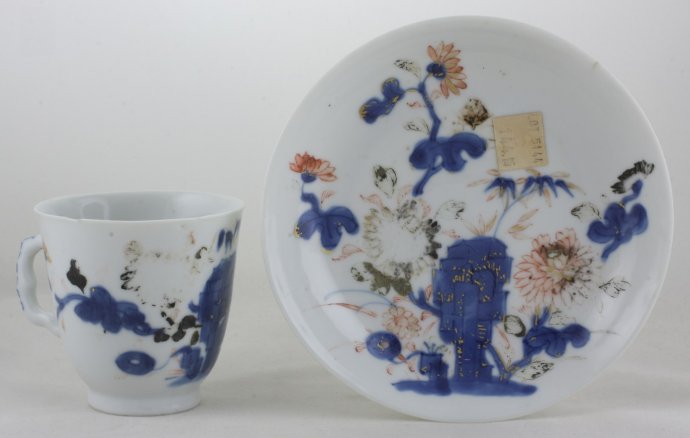
Sold Ceramics - Sold Shipwreck Porcelains - The Nanking Cargo, 1752 - Tea, Coffee and Chocolate wares - Page 1
Object 2012329
A chocolate cup and saucer
China
c.1751
Provenance: The Nanking Cargo sale, Christie's Amsterdam, 28 April - 2 May 1986
Height of cup 69 mm (2.72 inch), diameter of rim 73 mm (2.87 inch), diameter of footring 35 mm (1.38 inch), weight 99 grams (3.49 ounce (oz.))
Height of saucer 25 mm (0.98 inch), diameter of rim 133 mm (5.24 inch), diameter of footring 78 mm (3.07 inch), weight 98 grams (3.46 ounce (oz.))
A chocolate cup and saucer on footrings, straight sides, slightly everted rim and scalloped handles. Chinese Imari, decorated in underglaze blue, overglaze iron-red and gold with the "Chrysanthemum Rock" pattern in blue and enamels. Painted with chrysanthemum, bamboo and daisy issuing around a jagged outcrop of rockwork, the tall tapering cup with elaborate scalloped loop handle of European inspiration. Inside the cup and in the centre of the saucer the original rectangular paper Christie's lot 5144/144 label. On the bases of both the cup and the saucer the original circular paper Christie's The Nanking Cargo sale lot 5144 labels proving they have been one of 144 similar chocolate cups and saucers sold in lot 5144. (Amsterdam 1986, p.235)
In the auction catalogue 'The Nanking Cargo, Chinese Export porcelain and Gold', Christie's Amsterdam describes these chocolate cups as teacups.
Jörg states that in orders, shipping invoices and unpacking books from this period two types of chocolate cups and saucers are mentioned: with and without handles. The order for 1761 gives an exact description of such a cup: 70 mm (2.76 inch) high, with straight sides slightly sloping outwards and a diameter equal to its height. We even have a drawing of such a chocolate cup, part of the order made up in 1759. It looks exactly like the cups with scalloped handles found in the wreck. There is no question but that these are indeed chocolate cups. The same decoration of large flowers and bamboo near a rock is executed both in underglaze blue and Imari, as well in enamel colours. In all, 9,735 cups and saucers for chocolate had been bought in Canton. They also included enamelled high cups with round handles, which are indicated as a type in the drawing of 1758 too. Hatcher has recovered 2,263 pairs of chocolate cups and saucers with scalloped handles and 1.996 pairs with round handless. Apparently there were no chocolate cups without handle bought in 1751. (Jörg 1986/1, pp. 68-69)
Cups of this shape, which always have a handle, are usually called coffee cups, but in fact are chocolate cups. This is made clear from the numerous references and descriptions of "chocolate cups with handles" in the records of the Dutch East India Company (VOC). Orders state that "the cups must be straight without overhanging rims", the cup narrower inside. An average height of 70 mm is given and is stressed that the diameter of the rim should be equal to the height. Drawn models of 1758 which have fortunately been preserved, show four cups of this shape with different handles, which are specified as "chocolate cups" in the description. Large tea, coffee and chocolate services always included this type of cup, but they could be bought separately as well. Enamelled cups and saucers were bought by the Company for around 20 cents and sold in the Netherlands for around 50 cents apiece. (Jörg & Van Campen 1997, p.215)
(Reproduced from; The Geldermalsen. History and Porcelain, (C.J.A. Jörg, Groningen 1986), p.69, fig. 56.)
The design on these chocolate cups is known as the 'Chrysanthemum Rock' pattern in blue and enamels. In total 1,469 chocolate cups and saucers with the 'Chrysanthemum Rock' pattern in blue and enamels, were sold divided over the lots: 5139-5151 (Amsterdam 1986)
For a sold chocolate cup decorated the 'Chrysanthemum Rock' pattern in enamels, please see:
Condition:
Cup: Two fleabites and a chip tpo the rim.
Saucer: A short hairline to the rim.
References:
Jörg 1986/1, pp.39-59 & fig. 54, 55 & 56
Sheaf & Kilburn 1988, p.27 & Pl.146
Jörg & Van Campen 1997, cat. 240
Price: Sold.
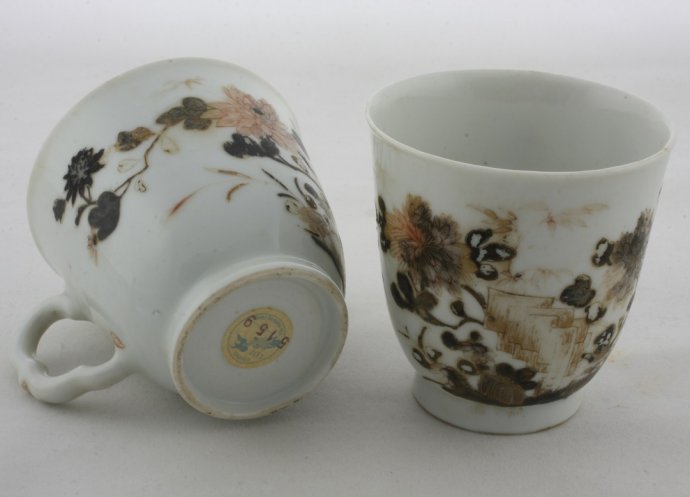
Sold Ceramics - Sold Shipwreck Porcelains - The Nanking Cargo, 1752 - Tea, Coffee and Chocolate wares - Page 1
Objects 2010967 and 2010968
A pair of chocolate cups
China
c.1751
Provenance: The Nanking Cargo sale, Christie's Amsterdam, 28 April - 2 May 1986
Heights 68 mm (2.68 inch), diameter of rims 68 mm (2.68 inch), diameter of footrings 39 mm (1.54 inch)
A pair of chocolate cups on footrings, straight sides, slightly everted rim and scalloped handles. Polychrome decorated in various overglaze enamels and gold with the "Chrysanthemum Rock" pattern in enamels. Painted with chrysanthemum, bamboo and daisy issuing around a jagged outcrop of rockwork with an elaborate scalloped loop handle of European inspiration. On the bases of both chocolate cups the original circular paper Christie's The Nanking Cargo sale lot 519 labels proving they have been two of 130 similar saucers sold in lot 5159. (Amsterdam 1986, p.236)
In the auction catalogue 'The Nanking Cargo, Chinese Export porcelain and Gold', Christie's Amsterdam describes these chocolate cups as teacups.
Jörg states that in orders, shipping invoices and unpacking books from this period two types of chocolate cups and saucers are mentioned: with and without handles. The order for 1761 gives an exact description of such a cup: 70 mm (2.76 inch) high, with straight sides slightly sloping outwards and a diameter equal to its height. We even have a drawing of such a chocolate cup, part of the order made up in 1759. It looks exactly like the cups with scalloped handles found in the wreck. There is no question but that these are indeed chocolate cups. The same decoration of large flowers and bamboo near a rock is executed both in underglaze blue and Imari, as well in enamel colours. In all, 9,735 cups and saucers for chocolate had been bought in Canton. They also included enamelled high cups with round handles, which are indicated as a type in the drawing of 1758 too. Hatcher has recovered 2,263 pairs of chocolate cups and saucers with scalloped handles and 1.996 pairs with round handless. Apparently there were no chocolate cups without handle bought in 1751. (Jörg 1986/1, pp. 68-69)
Cups of this shape, which always have a handle, are usually called coffee cups, but in fact are chocolate cups. This is made clear from the numerous references and descriptions of "chocolate cups with handles" in the records of the Dutch East India Company (VOC). Orders state that "the cups must be straight without overhanging rims", the cup narrower inside. An average height of 70 mm is given and is stressed that the diameter of the rim should be equal to the height. Drawn models of 1758 which have fortunately been preserved, show four cups of this shape with different handles, which are specified as "chocolate cups" in the description. Large tea, coffee and chocolate services always included this type of cup, but they could be bought separately as well. Enamelled cups and saucers were bought by the Company for around 20 cents and sold in the Netherlands for around 50 cents apiece. (Jörg & Van Campen 1997, p.215)
The design on these chocolate cups is known as the 'Chrysanthemum Rock' pattern in enamels. In total 33 teacups and saucers and 690 teacups without saucers with the 'Chrysanthemum Rock' pattern in enamels, were sold divided over the lots: 5152-5159 (Amsterdam 1986)
Condition:
2010967: A firing flaw hairline to the scalloped handle and a fleabite and frit to the rim.
2010968: A firing flaw to the rim and to the scalloped handle.
References:
Jörg & Van Campen 1997, cat. 240
Price: Sold.
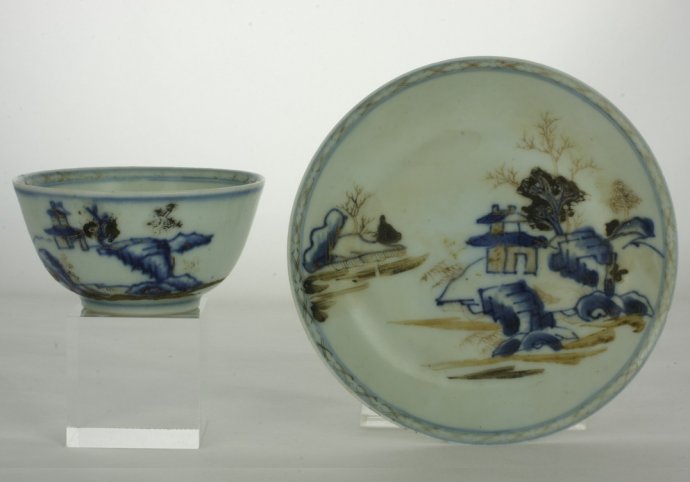
Sold Ceramics - Sold Shipwreck Porcelains - The Nanking Cargo, 1752 - Tea, Coffee and Chocolate wares - Page 1
Object 2010507
Teacup and saucer
China
Provenance: The Nanking Cargo sale, Christie's Amsterdam, 28 April - 2 May 1986
1752
Height of teacup 39 mm (1.46 inch), diameter of rim 75 mm (2.95 inch), diameter of footring 35 mm (1.38 inch), weight 46 grams (1.62 ounce (oz.))
Height of saucer 19 mm (0.75 inch), diameter of rim 117 mm (4.61 inch), diameter of footring 70 mm (2.76 inch), weight 56 grams (1.98 ounce (oz.))
Teacup and saucer on footrings, straight rims. Chinese Imari, decorated in underglaze blue, iron-red and gold with a double-roofed pavilion on the slope of a riverbank, a leafy tree overhanging at the back and two outcrops of rock sloping down to the water, a smaller island at the left, beneath a band of trellis-pattern at the rim. The reverses are undecorated. The teacup is decorated en suite. On the bases both teacup and saucer the original circular paper Christie's The Nanking Cargo sale lot 5191 labels proving they have been one of 288 similar teacups and saucers sold in lot 5191. (Amsterdam 1986, p.239)
The design on this teacup and saucer is known as the 'Imari Pavilion' pattern. In total 2,982 teacups and saucers and 934 teacups without saucers with the 'Imari Pavilion' pattern, were sold divided over the lots: 5179-5196 and 5197-5203. (Amsterdam 1986)
Condition teacup: A very tiny fleabite to the rim.
Condition saucer: A few very tiny fleabites to the rim.
References:
Price: Sold.
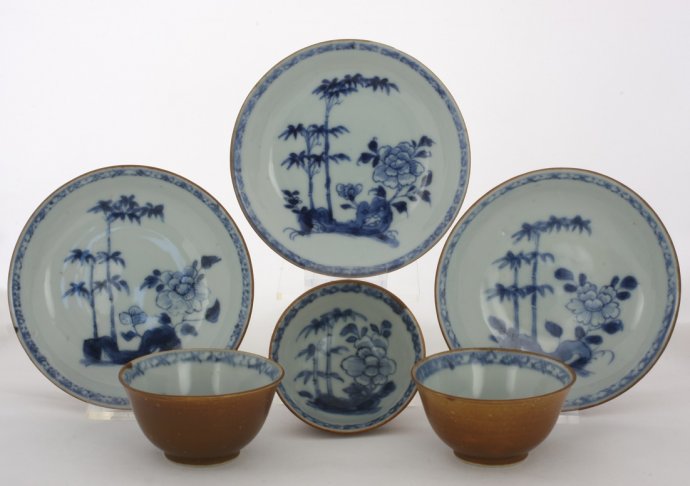
Sold Ceramics - Sold Shipwreck Porcelains - The Nanking Cargo, 1752 - Tea, Coffee and Chocolate wares - Page 1
Objects 2010293, 2010294 and 2010295
Three pairs of teacups and saucers
China
c.1751
Provenance: The Nanking Cargo sale, Christie's Amsterdam, 28 April - 2 May 1986
Height of teacups 39 mm (1.54 inch), diameter of rims 75 mm (2.95 inch), diameter of footrings 32 mm (1.26 inch)
Height of saucers 23 mm (0.91 inch), diameter of rims 120 mm (4.72 inch), diameter of footrings 66 mm (2.60 inch)
Three teacups and saucers on footrings, straight rims. Batavia Brown covered with underglaze dark brown and underglaze-blue with a double clump leafy bamboo to the left of a cluster of flowering peony. The reverses are covered in underglaze dark brown. The teacups are decorated en suite. On the bases the original circular paper Christie's The Nanking Cargo sale lot 5223 labels proving they have been three of 80 similar teacups and saucers sold in lot 5223. (Amsterdam 1986, p.241)
The design on these teacups and saucers is known as the 'Batavian Bamboo and Peony' pattern. In total 6,100 teacups and saucers and 3,064 saucers without teacups with the 'Batavian Bamboo and Peony' pattern were sold divided over the lots: 5204-5247 and 5248-5260. (Amsterdam 1986)
Condition:
Teacups: On one teacup a hairline to the rim.
Saucers: All perfect.
References:
Amsterdam 1986, pp.241-243, lots 5204-5260
Price: Sold.
More pictures of object 2010293 >>
The objects 2010294 and 2010295, two other identically shaped, sized and decorated, sold teacups and saucers, are not illustrated.
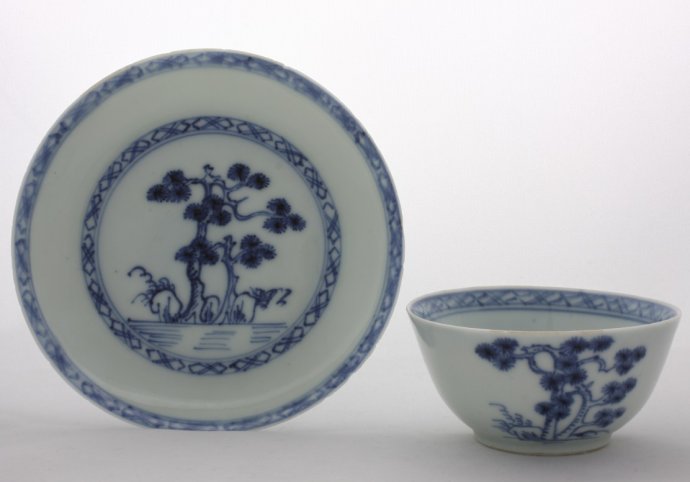
Sold Ceramics - Sold Shipwreck Porcelains - The Nanking Cargo, 1752 - Tea, Coffee and Chocolate wares - Page 1
Object 20100
Teacup and saucer
China
c.1751
Provenance: The Nanking Cargo sale, Christie's Amsterdam, 28 April - 2 May 1986
Height of teacup 37 mm (1.46 inch), diameter of rim 75 mm (2.95 inch), diameter of footring 35 mm (1.38 inch)
Height 20 mm (0.79 inch), diameter of rim 115 mm (4.53 inch), diameter of footring 66 mm (2.60 inch)
Teacup and saucer on footrings, straight rims. Decorated in underglaze blue with a cenral roundel filled with two leafy pines intertwining on a grassy rocky terrace surrounded by a trellis-pattern border. Round the rim another trellis-pattern border. The reverse is undecorated. The teacup is decorated en suite. On both teacup and saucer the original circular paper Christie's The Nanking Cargo sale lot 5534 labels proving it has been one of 1000 similar teacups and saucers sold in lot 5534. (Amsterdam 1986, p.252)
The design on this teacup and saucer is known as the 'Blue Pine' pattern, large size. In total 10,484 teacups and saucers and 1,860 teacups without saucers with the 'Blue Pine' pattern, large size, were sold divided over the lots: 5501-5537 and 5538-5550. (Amsterdam 1986)
Condition:
Teacup: Perfect.
Saucer: A few very tiny fleabites.
References:
Price: Sold.
More pictures of object 2010122K, another identically shaped, sized and decorated, sold saucer >>
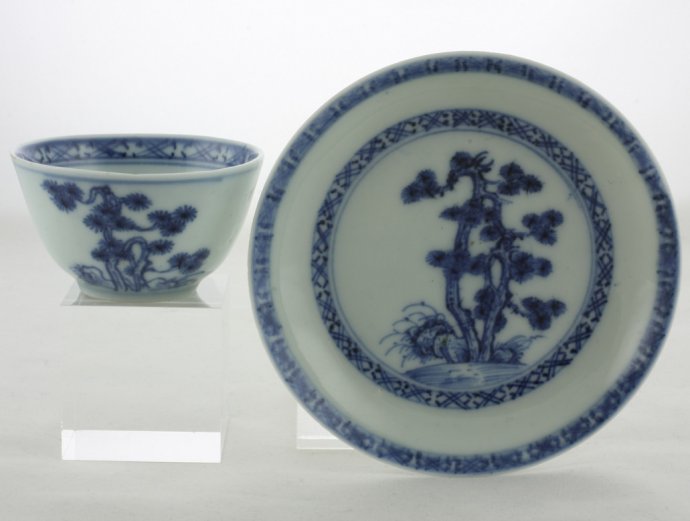
Sold Ceramics - Sold Shipwreck Porcelains - The Nanking Cargo, 1752 - Tea, Coffee and Chocolate wares - Page 1
Object 2010123
Teacup and saucer
China
c.1751
Provenance: The Nanking Cargo sale, Christie's Amsterdam, 28 April - 2 May 1986
Height of teacup 35 mm (1.38 inch), diameter of rim 65 mm (2.56 inch), diameter of footring 29 mm (1.14 inch)
Height of saucer 19 mm (0.75 inch), diameter of rim 103 mm (4.06 inch), diameter of footring 64 mm (2.52 inch)
Teacup and saucer footrings, straight rims. Decorated in underglaze blue with two leafy pines intertwining on a grassy rocky terrace in a central roundel surrounded by a trellis-pattern borde. Round the rim another trellis-patern border. The reverse is undecorated. The teacup is decorated en suite.On both teacup and saucer the original circular paper Christie's The Nanking Cargo sale lot 5576 label proving they have been one of 500 similar teacups and saucers sold in lot 5576. (Amsterdam 1986, p.252)
The design on this teacup and saucer is known as the 'Blue Pine' pattern, small size. In total 4,300 teacups and saucers and 1,788 saucers without teacups with the 'Blue Pine' pattern, small size, were sold divided over the lots: 5551-5578 and 5579-5599. (Amsterdam 1986)
Condition:
Teacup: Perfect..
Saucer: Perfect.
References:
Sheaf & Kilburn 1988. pp.102-114
Price: Sold.
More pictures of object 2010122L, another identically, shaped, sized and decorated, sold saucer >>
More pictures of object 2010122M, another identically, shaped, sized and decorated, sold saucer >>
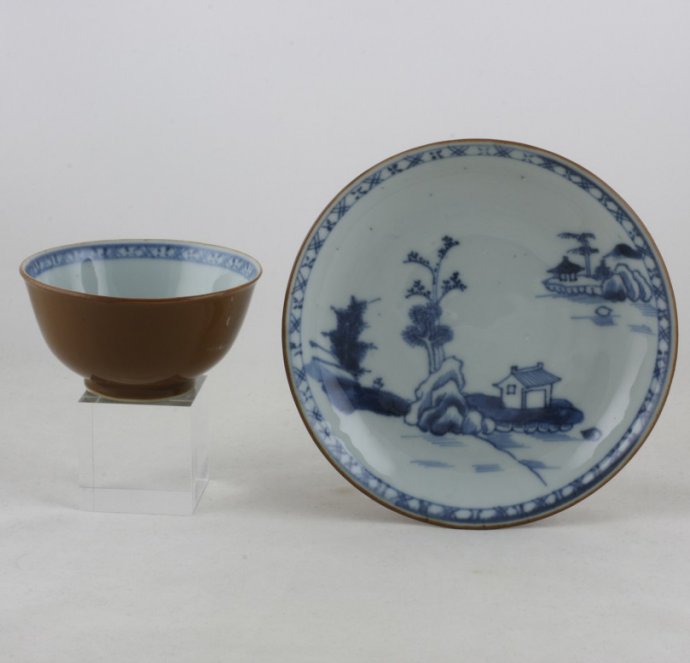
Sold Ceramics - Sold Shipwreck Porcelains - The Nanking Cargo, 1752 - Tea, Coffee and Chocolate wares - Page 1
Object 2012129
Coffee cup and saucer
China
c.1751
Provenance: The Nanking Cargo sale, Christie's Amsterdam, 28 April - 2 May 1986
Height of coffee cup 44 mm (1.73 inch), diameter of rim 83 mm (2.27 inch), diameter of footring 34 mm (1.34 inch), weight 111 grams (3.92 ounce (oz.))
Height of saucer 24 mm (0.94 inch), diameter of rim 132 mm (5.20 inch), diameter of footring 75 mm (2.95 inch), weight 61 grams (2.15 ounce (oz.))
Coffee cup and saucer on footring, straight rims. Batavia Brown covered with underglaze dark brown and underglaze-blue with a small open pavilion perched on a promontory within overhanging wintery foliage and evergreens, a wide river meandering past a similar retreat on an outcrop in the right background. The reverse is covered in underglaze dark brown. The teacup is decorated en suite. On the bases the original circular paper Christie's The Nanking Cargo sale lot 5612 labels proving they have been one of 30 similar teacups and saucers sold in lot 5612. (Amsterdam 1986, p.256)
The design on this coffee cup and saucer is known as the 'Batavian Pavilion' pattern. In total 1,674 coffee cups and saucers and 240 saucers without coffee cups with the 'Batavian Pavilion' pattern were sold divided over the lots: 5600-5638. (Amsterdam 1986, pp.256-258)
The market in the Netherlands for coffee- and tea cups and saucers seemed insatiable. Annually some 1000,000 cups and saucers arrive on each ship. The difference between a coffee cup and a tea cup was not yet clearly defined up till now, but Hatcher's find has made things easier. They are always cups without handles. The coffee cup is a little bigger and wider, on average with a diameter of 85 mm (3.35 inch) and a height of 45 mm (1.77 inch). Ordinary tea cups measure 75 mm (2.95 inch) diameter and 35 mm (1.38 inch) height, small tea cups 60 mm (2.36 inch) diameter and 33 mm (1.30 inch) height. The orders of the previous years show that the type with an even brown glaze on the outside is considered to be a coffee cup, for this type hardly occurs under the heading tea cup, or in small quantities only. This fits well with the recovered cargo: most brown cups are large, only one type is smaller and might have been a tea cup. According to the archives coffee- and tea cups with handles only became fashionable after 1760. (Jörg 1986/1. p.67).
In total eight different designs on tea- and coffee cups and saucers were discoverd. decorated in underglaze blue, Batavia Brown covered with underglaze dark brown and underglaze-blue and Chinese Imari.
Besides this 'Batavian Pavilion' pattern for examples of four of the other eight, previously sold, designs please see:
the 'Batavian Bamboo and Peony' pattern.
the 'Pagoda Riverscape' pattern in underglaze blue
the 'Blue Pine' pattern in underglaze blue
the 'Imari Pavilion' pattern
In the Netherlands, porcelain decorated in this type of underglaze brown has historically been called "Batavia Brown" or "Capucijnergoed" ("Chick-pea ware", after the legume). The first name may have been coined because most goods exported to The Netherlands from the East were sent via Batavia and has nothing to do with a Batavian production or decoration, It is a very common type with the decoration usually contained within medallions. Occasionally, a gold decoration has been painted on the brown glaze. The brown colour is achieved by using iron oxide as a pigment, which like underglaze blue, needs to be fired at high temperatures. Considerable quantities were exported to the Western and Inter-Asian markets from c.1700. The pieces are rarely refined and can be considered as articles for everyday use by the middle-classes. (Jörg 2002/2, p.120)
For an identically shaped, sized and decorated coffe cup and saucer, please see:
Condition:
Teacup: Perfect.
Saucer: A frit to the footring.
References:
Amsterdam 1986, pp.256-258, lots 5600-5638
Jörg 1986/1, pp.39-59 & fig. 48
Sheaf & Kilburn 1988, p.27 & Pl.153
Price: Sold.
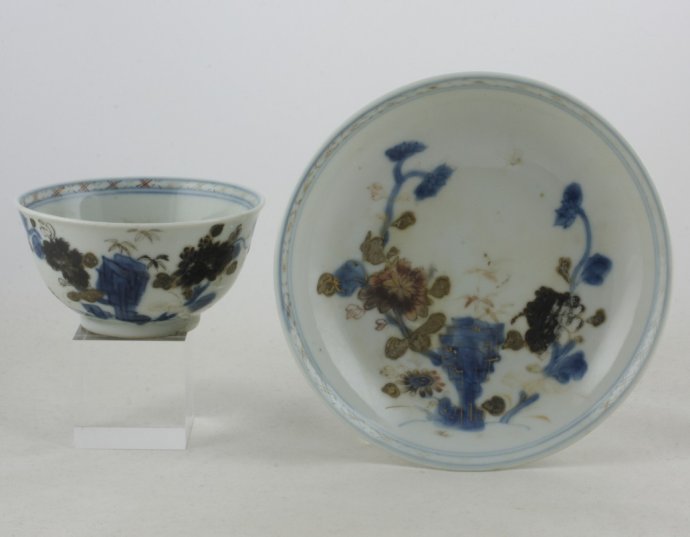
Sold Ceramics - Sold Shipwreck Porcelains - The Nanking Cargo, 1752 - Tea, Coffee and Chocolate wares - Page 1
Object 2012145
Teacup and saucer
China
1752
Provenance: The Nanking Cargo sale, Christie's Amsterdam, 28 April - 2 May 1986
Height of teacup 41 mm (1.61 inch), diameter of rim 89 mm (3.50 inch), diameter of footring 38 mm (1.50 inch), weight 70 grams (2.47 ounce (oz.))
Height of saucer 27 mm (1.06 inch), diameter of rim 136 mm (5.35 inch), diameter of footring 75 mm (2.95 inch), weight 122 grams (4.30 ounce (oz.))
Teacup and saucer on footrings, slightly everted rims. Chinese Imari, decorated in underglaze blue, iron-red and gold with the 'Chrysanthemum Rock' pattern in blue and enamels. Painted with chrysanthemum, bamboo and daisy issuing around a jagged outcrop of blue rockwork. On the rim a trellis-pattern border. The teacup is decorated en suite. On the saucer and teacup the original circular paper Christie's The Nanking Cargo sale label and on the teacup the original rectangular paper Christie's lot 5703/48 label, proving they have been one of 48 similar teacups and saucers sold in lot 5703. (Amsterdam 1986, p.263)
In total 1,382 teacups and saucers and 394 saucers without bowls with the 'Chrysanthemum Rock' pattern in blue and enamels were sold divided over the lots: 5693-5709 and 5710-5715. (Amsterdam 1986)
Condition: Both perfect.
References:
Sheaf & Kilburn 1988, p. 27 & Pl.146
Price: Sold.
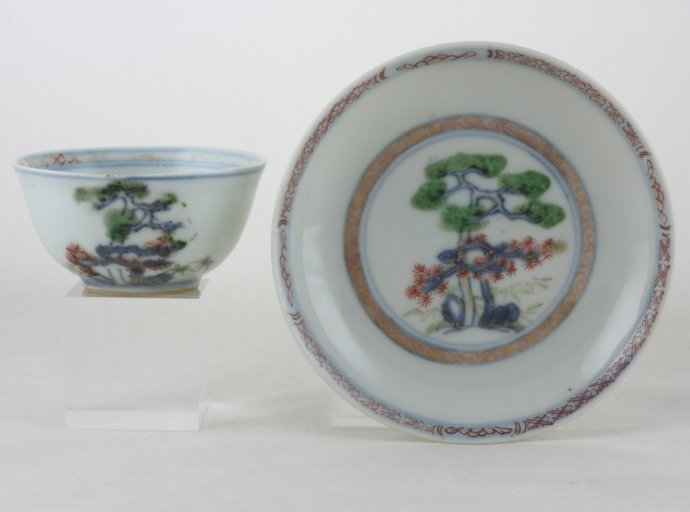
Sold Ceramics - Sold Shipwreck Porcelains - The Nanking Cargo, 1752 - Tea, Coffee and Chocolate wares - Page 1
Object 2011408
Teacup and saucer
China
Provenance: The Nanking Cargo sale, Christie's Amsterdam, 28 April - 2 May 1986
1752
Height of teacup 37 mm (1.46 inch), diameter of rim 75 mm (2.95 inch), diameter of footring 32 mm (1.26 inch), weight 43 grams (1.52 ounce (oz.))
Height of saucer 20 mm (0.79 inch), diameter of rim 115 mm (4.52 inch), diameter of footring 67 mm (2.64 inch), weight 62 grams (2.19 ounce (oz.))
Teacup and saucer on footrings, straight rims. Chinese Imari, decorated in underglaze blue, iron-red, gold and overglaze green enamel with a large leafy pine rising from a smaller cluster of bamboo on a terrace, within bands of scrolls, and trellis at the rim. The reverse is undecorated. The teacup is decorated en suite. On the bases of both the teacup and the saucers the original circular paper Christie's The Nanking Cargo sale lot 5727 labels proving they have been one of 125 similar teacups and saucers sold in lot 5727. (Amsterdam 1986, pp.264-265)
The design on this teacup and saucer is known as the 'The Bamboo and Pine' pattern. In total 1,037 teacups and saucers and 50 teacups without saucers with the 'The Bamboo and Pine' pattern, were sold divided over the lots: 5716-5733. (Amsterdam 1986, pp.264-265)
The iron-red, gold and green enamel overglaze decoration on this teacup and saucer has been very well preserved after being submerged in the salt sea water for 233 years. It gives a good impression of what the original overglaze decoration, often completely deteriorated by the salt sea water, originaly looked like.
Condition teacup: A short hairline to the rim.
Condition saucer: Two firing tension hairlines (only visible on one side), caused by the firing process.
References:
Price: Sold.


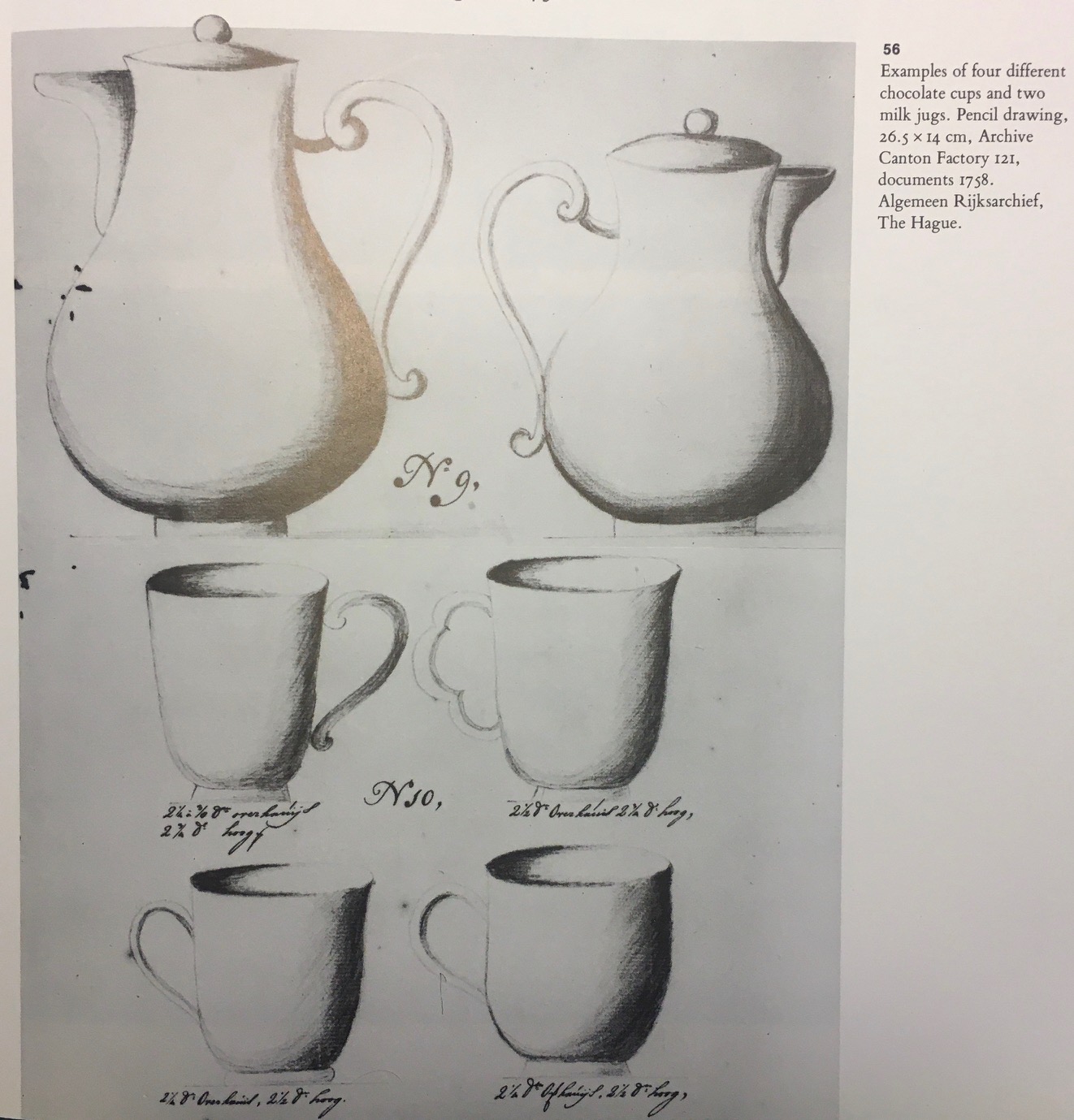
 create websites
create websites